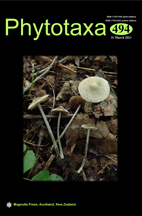Abstract
Several species and nothospecies of Kalanchoe Adanson (1763: 248) (Crassulaceae subfam. Kalanchooideae) that use multiple vegetative and reproductive methods of self-propagation have become weedy in especially mild-climate parts of the world (Garcês et al. 2007, Herrera & Nassar 2009, Smith 2019, Smith et al. 2019: 244–278). Some of these, including the nothospecies K. ×houghtonii Ward (2006: 94) (Smith 2019) and its two parent taxa, K. daigremontiana Raymond-Hamet & Perrier de la Bâthie (1914: 128) (Figs 1 & 2) and K. tubiflora (Harvey 1862: 380) Hamet (1912: 44), have taken on economic importance beyond being sold, in many instances unwisely, as ornamental plants in the horticultural trade, as their eradication from places where they have become established in vegetation well away from their natural habitats will require the investment of fiscal resources.

